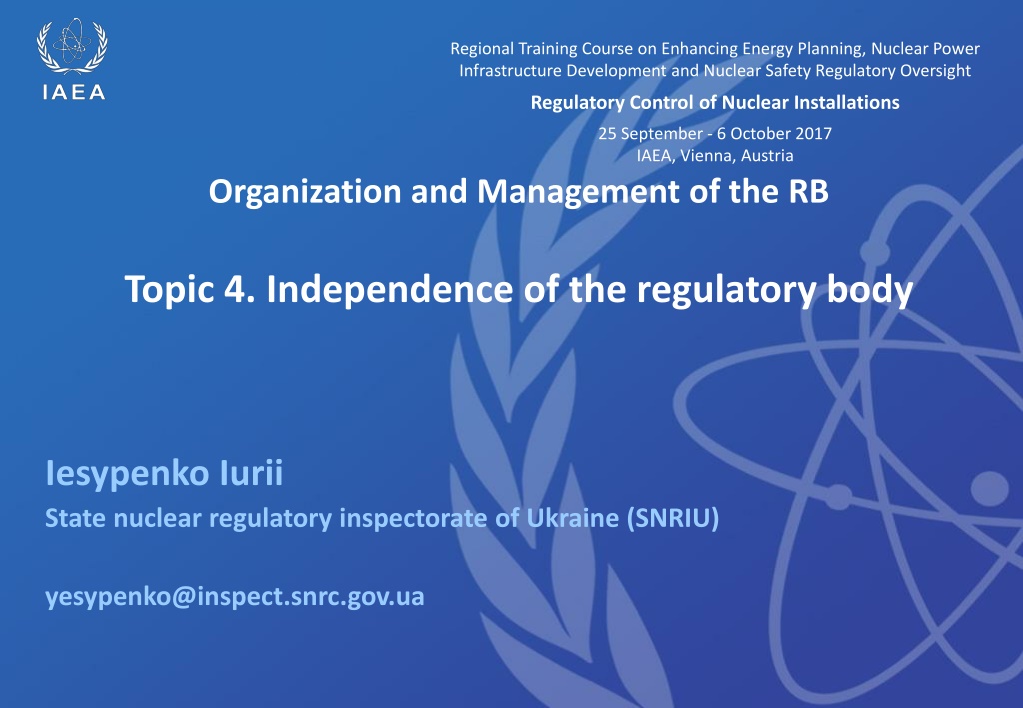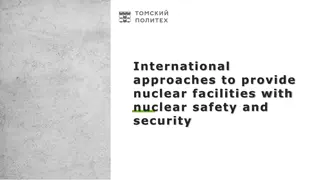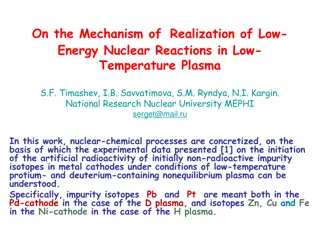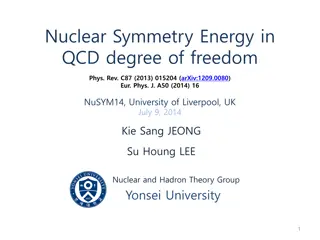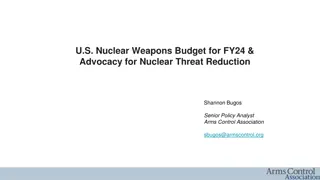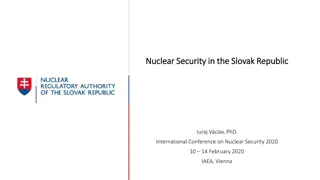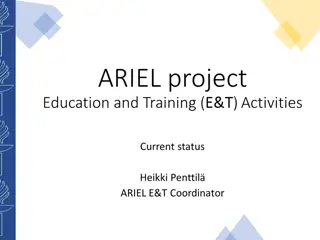Importance of Regulatory Independence in Nuclear Energy Governance
The significance of regulatory independence in nuclear energy governance, including its legal basis, political aspects, and constraints. Learn about international obligations and effective practices to ensure safety and transparency.
Download Presentation

Please find below an Image/Link to download the presentation.
The content on the website is provided AS IS for your information and personal use only. It may not be sold, licensed, or shared on other websites without obtaining consent from the author. Download presentation by click this link. If you encounter any issues during the download, it is possible that the publisher has removed the file from their server.
E N D
Presentation Transcript
Regional Training Course on Enhancing Energy Planning, Nuclear Power Infrastructure Development and Nuclear Safety Regulatory Oversight Regulatory Control of Nuclear Installations 25 September - 6 October 2017 IAEA, Vienna, Austria Organization and Management of the RB Topic 4. Independence of the regulatory body Iesypenko Iurii State nuclear regulatory inspectorate of Ukraine (SNRIU) yesypenko@inspect.snrc.gov.ua
Learning objectives - To understand Why independence of the regulatory body is important and how this is achieved in practice. The political aspects of regulatory independence. The importance of openness and transparency for the regulatory body and how these relate to regulatory body independence. 25 September - 6 October 2017 2
Contents Importance, legal basis, limitations Political aspects Openness and transparency 25 September - 6 October 2017 3
Introduction Topic 4. Independence of the regulatory body 25 September - 6 October 2017 4
International obligations Article 8 of the Convention on Nuclear Safety states that there has to be: an effective separation between the functions of the regulatory body and those of any other body or organization concerned with the promotion or utilization of nuclear energy Similar wording in GSR Part 1 (Rev. 1), Joint Convention Topic 4. Independence of the regulatory body 25 September - 6 October 2017 5
Effective independence The regulatory body has the legal authority, technical competence and resources to regulate nuclear installations and activities; and its regulatory decisions are free from undue political and economic influence. This will ensure that regulatory decisions are made and enforcement actions taken only in the best interest of safety. Topic 4. Independence of the regulatory body 25 September - 6 October 2017 6
Constraints Part of government National system of laws Budget constraints, financing Accountability to national authorities, elected officials and public Best option is if all these constraints are regulated by law. Topic 4. Independence of the regulatory body 25 September - 6 October 2017 7
Professional approach The regulatory body itself must perform its functions and conduct its daily business in such a way that it does not compromise its independence. The staff of the regulatory body must follow the rules Guidance on sensitive aspects of activities should be developed Q: What sensitive aspects can you think of? Topic 4. Independence of the regulatory body 25 September - 6 October 2017 8
Competence and equipment Regulatory body should have enough competence and be well equipped to meet any challenges to its independence in regulatory decision making in matters of nuclear safety. Topic 4. Independence of the regulatory body 25 September - 6 October 2017 9
Framework of independence Legal framework governing regulatory activities Financing of regulatory activities Clearly defined processes for regulatory decision making Competence management programme for the regulatory body Independent scientific and technical support Access to international cooperation Topic 4. Independence of the regulatory body 25 September - 6 October 2017 10
Openness and transparency - Communication Openness and transparency are means to promote independence in regulatory decision making and to demonstrate this independence to government, licensees, other interested parties, and the public. The regulatory body must have not only the authority, but also the obligation to communicate its regulatory decisions. Topic 4. Independence of the regulatory body 25 September - 6 October 2017 11
Openness and transparency - Audit A systematic programme for professional reviews and audits of regulatory performance including: Self assessment and reporting of performance indicators International cooperation (meetings, CNS review etc.) Formal internal quality audits and self-assessments at regular intervals External peer reviews, such as those offered by the IAEA Topic 4. Independence of the regulatory body 25 September - 6 October 2017 12
Key points Independence is necessary for making safety the first priority Independence is not a goal but a tool which should be maintained consistently Transparency and active open communication is a valuable element for independence Topic 4. Independence of the regulatory body 25 September - 6 October 2017 13
Regional Training Course on Enhancing Energy Planning, Nuclear Power Infrastructure Development and Nuclear Safety Regulatory Oversight Regulatory Control of Nuclear Installations 25 September - 6 October 2017 IAEA, Vienna, Austria Thank you!
